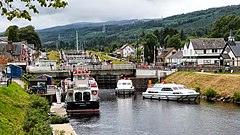Fort Augustus
Fort Augustus
| |
|---|---|
 Swing bridge and locks at Fort Augustus | |
Location within the Inverness area | |
| Population | 620 (mid-2020 est.)[2] |
| OS grid reference | NH379090 |
| • Edinburgh | 100 mi (161 km) |
| • London | 430 mi (692 km) |
| Council area | |
| Country | Scotland |
| Sovereign state | United Kingdom |
| Post town | Fort Augustus |
| Postcode district | PH32 4 |
| Dialling code | 01320 |
| Police | Scotland |
| Fire | Scottish |
| Ambulance | Scottish |
| UK Parliament | |
| Scottish Parliament | |

Fort Augustus is a settlement in the parish of Boleskine and Abertarff, at the south-west end of Loch Ness, Scottish Highlands. The village has a population of around 646 (2001).[3] Its economy is heavily reliant on tourism.
History

The
In the aftermath of the
In 1867, the fort was sold to the Lovat family, and in 1876 they passed the site and land to the
Infrastructure
The village is served by the A82 road and lies approximately midway between Inverness (56 km) and Fort William (51 km).
The village was served by a rail line from Spean Bridge to a terminus on the banks of Loch Ness from 1903 until 1933, built by the Invergarry and Fort Augustus Railway in the hope of eventually completing a line to Inverness and latterly operated by the North British Railway and its successor, the London and North Eastern Railway, but initially operated by the Highland Railway. The Caledonian Canal connecting Fort William to Inverness passes through Fort Augustus in a dramatic series of locks stepping down to Loch Ness.
The village is served by the Cill Chuimein Medical Centre.[11]
The village has both a primary school and a secondary school – Kilchuimen Primary School and Kilchuimen Academy – which share a campus.
Climate
As with most of the British Isles and Scotland, Fort Augustus has an oceanic climate (Köppen: Cfb) with cool summers and mild winters. Like a lot of the surrounding area, sunshine levels are low at around 1,000 hours per annum and temperatures are unpredictable – Fort Augustus holds the UK's joint lowest May temperature record of −9.4 °C (15.1 °F).[12] This is the latest point in the run-up to summer that such a low temperature has been recorded, suggesting it can become a frost trap on calm clear nights due to its valley location. That same low-lying topography can also give rise to some high temperatures on occasion – Fort Augustus held the UK daily high temperature record for 16 December for almost 80 years.[13]
| Climate data for Fort Augustus (23 m or 75 ft asl, averages 1991–2020) | |||||||||||||
|---|---|---|---|---|---|---|---|---|---|---|---|---|---|
| Month | Jan | Feb | Mar | Apr | May | Jun | Jul | Aug | Sep | Oct | Nov | Dec | Year |
| Mean daily maximum °C (°F) | 6.3 (43.3) |
6.9 (44.4) |
8.8 (47.8) |
11.9 (53.4) |
14.9 (58.8) |
16.8 (62.2) |
18.6 (65.5) |
18.5 (65.3) |
16.2 (61.2) |
12.1 (53.8) |
8.8 (47.8) |
6.5 (43.7) |
12.2 (53.9) |
| Mean daily minimum °C (°F) | 1.0 (33.8) |
1.1 (34.0) |
2.2 (36.0) |
3.7 (38.7) |
6.0 (42.8) |
9.1 (48.4) |
10.9 (51.6) |
10.6 (51.1) |
8.8 (47.8) |
5.7 (42.3) |
2.8 (37.0) |
0.8 (33.4) |
5.2 (41.4) |
| Average rainfall mm (inches) | 190.6 (7.50) |
132.5 (5.22) |
112.2 (4.42) |
66.8 (2.63) |
68.4 (2.69) |
67.4 (2.65) |
71.3 (2.81) |
93.2 (3.67) |
104.9 (4.13) |
140.3 (5.52) |
136.1 (5.36) |
175.8 (6.92) |
1,359.5 (53.52) |
| Average rainy days (≥ 1 mm) | 18.5 | 16.6 | 16.6 | 13.7 | 13.4 | 13.0 | 14.3 | 14.8 | 14.3 | 18.4 | 17.4 | 18.6 | 189.6 |
| Mean monthly sunshine hours | 26.2 | 54.5 | 82.4 | 128.3 | 162.5 | 129.5 | 115.4 | 113.0 | 91.1 | 56.4 | 27.1 | 18.5 | 1,004.9 |
| Source: Met Office[14] | |||||||||||||
Notable people
- Guy Prendergast (1905–1986), explorer and soldier. Buried in Strathoich cemetery.
See also
References
- ^ "Gaelic Place-Names of Scotland database". Ainmean-Àite na h-Alba. Archived from the original on 7 April 2016. Retrieved 7 May 2016.
- ^ "Mid-2020 Population Estimates for Settlements and Localities in Scotland". National Records of Scotland. 31 March 2022. Retrieved 31 March 2022.
- ^ "www.highland.gov.uk". Archived from the original on 20 December 2004.
- ^ "am baile - Fort Augustus". Archived from the original on 11 March 2007.
- ^ "Clan Comyn, Cumming". www.electricscotland.com.
- ^ MacMillan 3 Archived 28 September 2007 at the Wayback Machine
- ^ Caledonian Mercury 1 August 1727
- ^ "Loch Ness Webmaster, Tony Harmsworth". Archived from the original on 2 November 2019. Retrieved 11 July 2011.
- ^ Loch Ness, Nessie & Me (2011)
- ^ "The Lovat Hotel Loch Ness | 4 Star Luxury Hotel Fort Augustus". thelovat.com.
- ^ ICSH - Home Archived 12 March 2007 at the Wayback Machine
- ^ "May Temperature". TORRO. Archived from the original on 5 February 2015. Retrieved 2 November 2011.
- ^ "1893 Temperature". TORRO. Archived from the original on 24 August 2015. Retrieved 2 November 2011.
- ^ "Fort Augustus UK climate averages". Met Office. Retrieved 11 September 2019.

